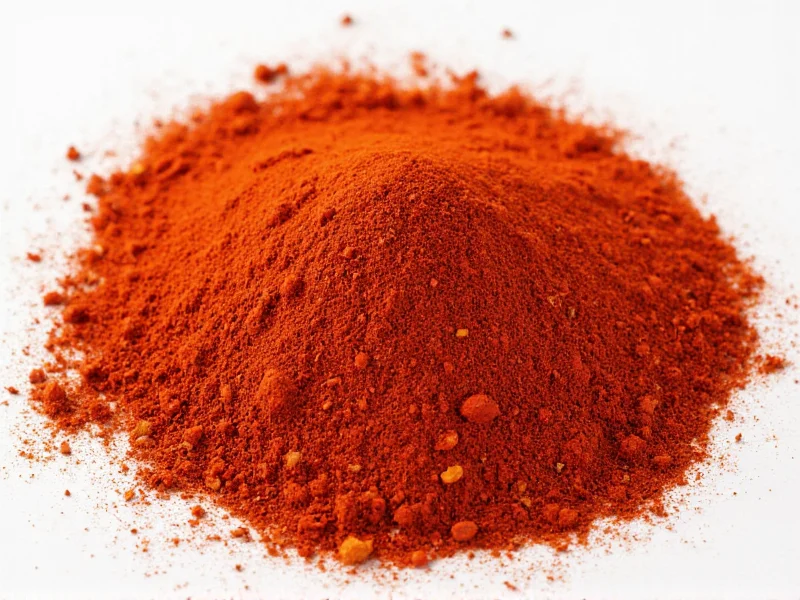Understanding paprika varieties is essential for home cooks and culinary enthusiasts who want to achieve authentic flavors in their dishes. This comprehensive guide explains the distinctions between sweet paprika and other paprika types, helping you make informed choices for your cooking needs.
What Exactly Is Paprika?
Paprika is a ground spice made from dried peppers belonging to the Capsicum annuum family. Originating in Central Mexico, it spread to Europe through trade routes and became particularly prominent in Hungarian cuisine. The flavor profile, color intensity, and heat level of paprika depend on the specific pepper varieties used and the production methods employed.
The Different Types of Paprika Explained
Not all paprika is created equal. The spice comes in several distinct varieties, each with unique characteristics:
| Type of Paprika | Heat Level | Flavor Profile | Primary Use |
|---|---|---|---|
| Sweet Paprika | Mild (0-500 SHU) | Bright red, sweet, slightly fruity | Coloring and mild flavor in dishes |
| Regular Paprika (Hungarian) | Mild to medium (500-1,500 SHU) | Earthy, slightly sweet with subtle warmth | Traditional Hungarian dishes |
| Hot Paprika | Medium to hot (5,000-15,000 SHU) | Spicy with underlying sweetness | Dishes requiring heat and color |
| Smoked Paprika (Pimentón) | Varies (sweet, medium, or hot) | Distinctive smoky flavor | Spanish cuisine, barbecue rubs |
Sweet Paprika vs. Regular Paprika: The Key Differences
The primary difference between sweet paprika and what's commonly called “regular paprika” lies in their flavor profiles and intended culinary applications. Sweet paprika delivers pure pepper sweetness without any heat, while “regular” paprika (often referring to standard Hungarian paprika) typically has a more complex flavor with subtle warmth.
Sweet paprika undergoes a specific production process using only sweet pepper varieties that contain no capsaicin, the compound responsible for heat in peppers. Regular paprika may contain a blend of sweet and mildly pungent peppers, resulting in that characteristic Hungarian warmth that's noticeable but not overwhelming.
Geographical Influences on Paprika Varieties
Regional production significantly impacts paprika characteristics:
- Hungarian Paprika: Considered the gold standard, with eight official classifications ranging from sweet to hot. The most common “regular” Hungarian paprika (also called “rose” or “classic”) offers balanced flavor with mild heat.
- Sweet Spanish Paprika (Pimentón Dulce): Made from sweet peppers dried over oak fires, offering a milder alternative to smoked varieties.
- American Paprika: Often labeled simply as “paprika,” typically refers to the sweet variety unless specified as hot.
When to Use Sweet Paprika vs. Regular Paprika
Choosing the right paprika makes a significant difference in your culinary results:
Use sweet paprika when you want vibrant red color without any heat. It's ideal for deviled eggs, potato salads, light-colored sauces, and dishes where you want pure pepper flavor without warmth. Sweet paprika works well in recipes for children or those sensitive to spice.
Opt for regular paprika (typically Hungarian style) when you want that authentic Central European flavor profile with subtle warmth. It's essential for traditional dishes like goulash, chicken paprikash, and Hungarian stews where the mild heat enhances other flavors without dominating the dish.
Substitution Guide for Paprika Varieties
Understanding paprika differences helps with smart substitutions:
- If a recipe calls for sweet paprika and you only have regular paprika, use about 75% of the amount called for to avoid unexpected heat.
- When substituting sweet paprika for regular paprika, you'll lose the subtle warmth but gain pure color and sweetness.
- Never substitute hot paprika for sweet paprika unless you want to significantly increase the dish's heat level.
- Smoked paprika creates an entirely different flavor profile and shouldn't substitute for sweet or regular paprika unless the recipe specifically calls for smokiness.
Buying and Storing Paprika for Maximum Flavor
To ensure you get the best quality paprika:
- Check the label for specific variety information rather than just “paprika”
- Look for paprika in dark glass containers or opaque packaging to protect from light degradation
- Fresh paprika should have a vibrant red color and aromatic scent
- Store in a cool, dark place and use within 6-12 months for optimal flavor
- Consider buying smaller quantities more frequently as paprika loses potency over time
Common Misconceptions About Paprika
Many home cooks misunderstand paprika varieties. The term “regular paprika” creates confusion because its meaning varies by region. In American grocery stores, “paprika” often means sweet paprika, while in European contexts, it typically refers to the traditional Hungarian variety with mild heat.
Another misconception is that all paprika provides significant heat. In reality, sweet paprika contains zero capsaicin and won't add any spiciness to your dishes. Understanding these distinctions prevents recipe failures and helps you achieve the intended flavor profile.
Practical Applications in Cooking
Sweet paprika excels in dishes where color matters more than heat. Sprinkle it on roasted potatoes, mix into mayonnaise for sandwiches, or use in light-colored soups and sauces where you want vibrant color without altering the flavor profile significantly.
Regular paprika shines in traditional European recipes where its subtle warmth complements other spices. It forms the flavor base for many stews, braises, and meat dishes, particularly when combined with onions and other aromatics in the early cooking stages.











 浙公网安备
33010002000092号
浙公网安备
33010002000092号 浙B2-20120091-4
浙B2-20120091-4